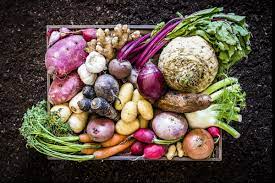Last Updated on April 15, 2024 by Real Men Sow
Poor root vegetables, they are shabby, ill-shaped, and lack the sexiness of tomatoes, the trendiness of kale, or the smooth beauty that eggplants have.
Root vegetables are strange and people don’t know what to do. I’ve been approached by people in grocery stores asking me what that bulbous, hairy thing was. They won’t believe me if I tell them it’s celeriac, since they don’t know the name.
Celeriac
Celeriac, also known as celery root, is a mild celery flavor that disguises its bumpy appearance. In case you were wondering, a celeriac is not the root of a celery tree, but a relative that has carrots and parsley.
You can either grate the fruit and cook it or use it as a vegetable stock. It’s more starchy than potatoes, but it’s not as watery as jicama in terms of texture. It can be mashed or blended with potatoes to make delicious soups. Celeriac is rich in fiber, potassium and calcium as well as vitamin B, vitamin C, vitamin K, and vitamin B.
Jerusalem Artichokes
These tubers are not from Jerusalem or an artichoke. They are actually sunflower tubers and likely got their name from “girasole”, the Italian word for sunflower. These tubers look like ginger root, and they have a crispy, nutty taste, especially when sauteed.
Jerusalem Artichokes make great soups, whether you pickle them or roast them. They are a great substitute for potatoes and taste sweeter than starchy. They taste similar to a mild mustard or raw chestnut when eaten raw.
Parsnips
Parsnips look like anemic carrots, and they are naturally sweet. It can be used in soups, stews, and are delicious roasted. Parsnips are rich in vitamins and potassium, which is why they are more nutritious than the carrot. Footprint reports parsnips have potential cancer-fighting properties. This is due to a phytochemical called Falcarinol.
Although the roots can be touched with ease, the chemical burn that can occur when handling the shoots or leaves can be severe. It is best to use gloves and long sleeves when gardening. The tops are usually removed when the parsnips are sold in stores. You should look for a firm, but not too woody, parsnip. It shouldn’t be bendable.
Rutabaga
The rutabaga was a staple in my childhood. It was originally a mix of a turnip and a cabbage. They can be roasted, mashed, or added to soups. You will find a lot of vitamin C in these 100g. This will give you about 40% of your daily requirements. You will also find a lot of vitamin A, beta-carotene and vitamin E.
Rutabagas can be waxed to extend their shelf life. This can be done with a vegetable peeler before cooking. The root vegetable can be stored in a cool place for several months, or it can be kept in the field to overwinter.
Sweet Potatoes
Sweet potatoes are often mistaken for yams. However, they are two different things and not even in the same botanical family. You can make sweet potatoes in many different ways. They can be roasted, fried or baked in bread.
Sweet potatoes are high in vitamin C and vitamin B, as well as having more beta-carotene than any other vegetable. It’s important to not store them in the refrigerator as it can ruin their texture and taste. You can use it within a few weeks after purchase in a dry, cool and ventilated container.
Turnips
Turnips, like horseradish, radishes, and rutabagas are all members of the mustard family. They are considered cruciferous vegetables. You can roast them, or use them in soups and stews. It is interesting to note that the turnip has very little nutritional value, aside from vitamin C.
They have a classic two-tone appearance with some purple and some white. But they don’t have to be that way. Some are all white, amber or green. You can find turnips that are younger and sweeter at farmer’s markets. If you spot them in spring, grab them and make a salad with them.

